I am 32 years old this year, started trading cryptocurrencies at 22, and my funds reached eight digits in 2023-2024. My life now involves staying at high-end hotels around 2000 yuan, and my luggage and hats may carry crypto symbols. It's much more comfortable than what the older generation did in industry or the e-commerce endeavors of the post-80s.
I have hardly experienced business disputes, with fewer worries.
The most crucial point in trading cryptocurrencies is having a good mindset; technique comes second.
In the crypto world, only these two types of people can make money.
The first type waits patiently to remain in cash, looking for a significant drop, adding self-identified valuable coins to favorites, and when a major market drop occurs, they buy in fully and profit significantly.
The second type, value investors, buy during bear markets, acquire high-quality coins, hold long-term, invest regularly and repeatedly, letting compound interest roll and explode. By achieving these two points, you can definitely outperform 90% of retail investors in the crypto world chasing highs and cutting losses while saving effort and worry.
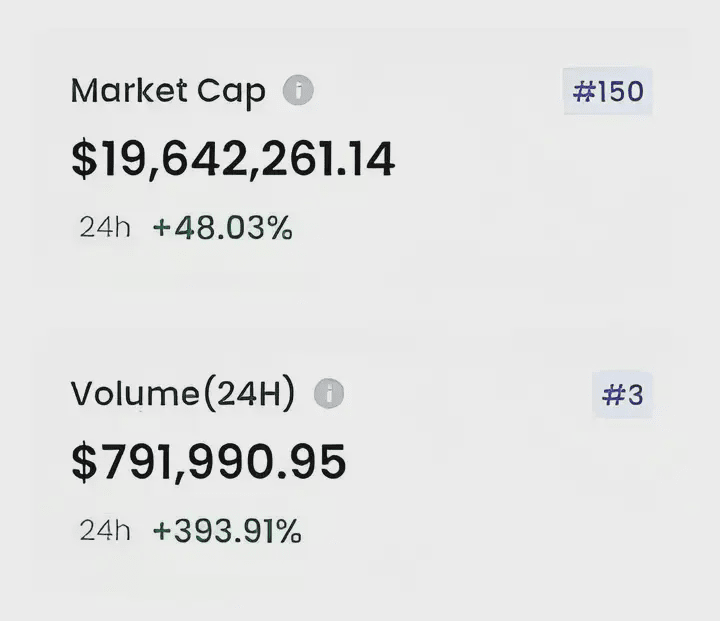
After 10 years of trading cryptocurrencies, from huge losses to great gains, I have summarized 10 iron rules to give all retail investors a piece of advice! If you want to play in the crypto world for the long term, please carefully read this heartfelt article! Newcomers must remember these rules to navigate the market skillfully.
The crypto world is a world full of opportunities and risks, especially for newcomers. Knowing how to survive and profit in a highly volatile market is a discipline that requires constant learning and practice.

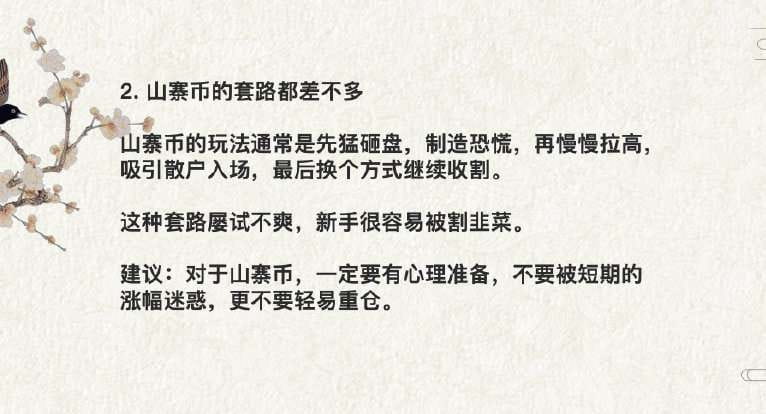
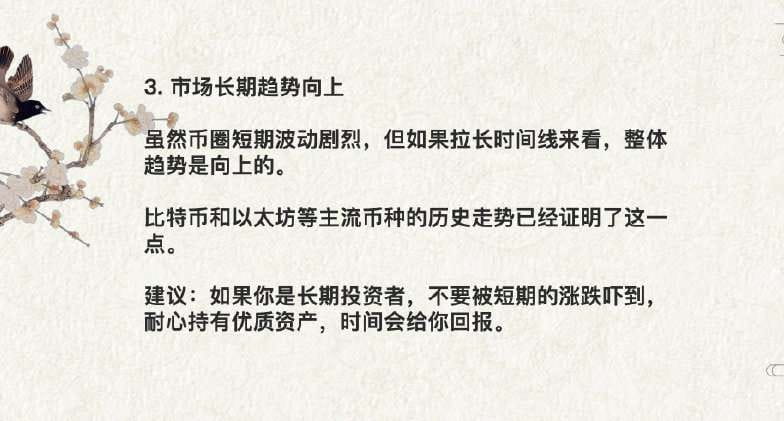


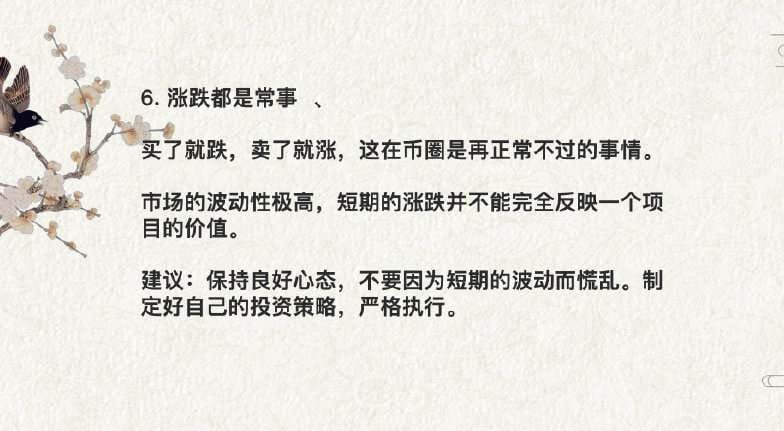
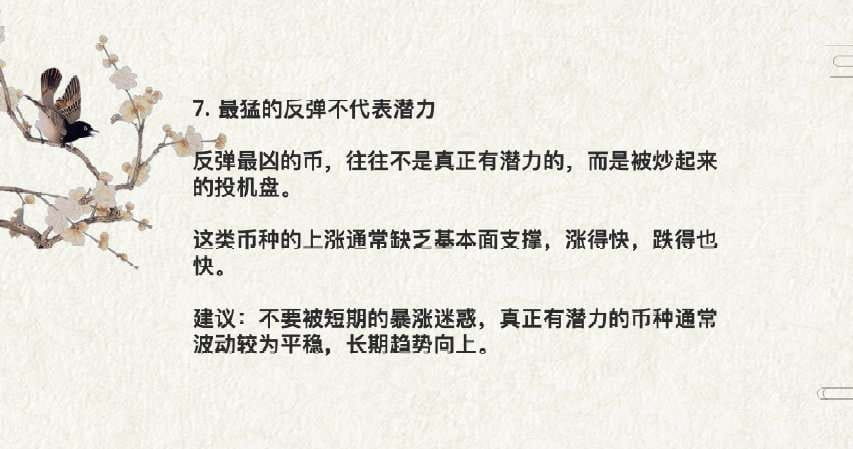

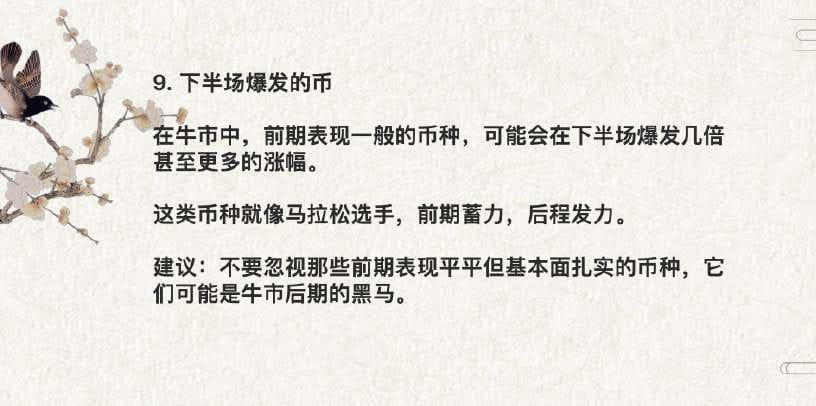
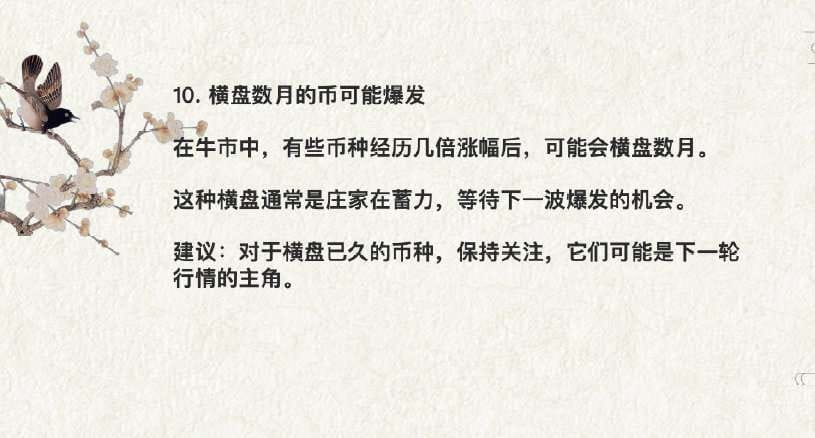
Finally, to summarize: the two key factors for survival in the crypto world
If you feel confused or at a loss in your operations, remember the following two points:
1. Take action decisively: Opportunities are fleeting; decisive action is necessary to seize them.
2. Stay online: The crypto world changes rapidly; it is crucial to get the latest news and respond promptly. The crypto market is challenging, but as long as you grasp these iron rules, stay calm and rational, you can find your opportunity in this market. Remember, investing is a marathon, not a sprint; patience and strategy are key to success!
Some strategies or points to note for short-term investments:
1. Position: Short-term positions don't need to be too large, at most occupying 10% of the total position, with the rest in long-term or for averaging down. After all, long-term positions are the foundation of our profits.
2. Cryptocurrency: Although it's about short-term trading, try not to touch cryptocurrencies you don't understand. Prioritize those you are familiar with and can comprehend. If it's a bear market, it's recommended to only deal with mainstream coins, or even Bitcoin, because these coins, even if stop-loss is not timely, being trapped or losing is only temporary, whereas altcoins may not be. Being trapped could mean forever.
3. Time: Personally, I define short-term trading as within half a month or even a month. Unless you can constantly monitor the market or have related automated software, it's not advisable to engage in trades lasting a few hours. The specific short-term timeframe should depend on market trends, ranging from a few days to about ten days.
4. Take-profit and stop-loss: I found that significant losses in short-term trading are often due to untimely take-profit or stop-loss. Therefore, when participating in short-term trading, everyone must make a rough take-profit and stop-loss plan. This plan doesn't need to be too detailed; a general direction is sufficient, and then adjust according to market changes.
In addition to sharing some short-term trading techniques, I have also summarized some tips for trading cryptocurrencies, hoping to help investors.
1. Familiarize yourself with various candlestick chart technical analyses.
2. Do not go all-in or all-out in a short time.
3. Set a military order for yourself to take timely profits and stop losses.
4. Try not to operate during rapid rises and falls.
5. Don't put too much pressure on yourself; maintain a balanced mindset.
6. Don't look at too many analyses from others; everyone says different things. Price movements are influenced by many factors, and predictions about the future are fifty-fifty, half right and half wrong. Just trust yourself.
7. Excessive trading can affect physical health, but when significant upward or downward trends arrive, one must use their wisdom to go long or short to profit.
A big reveal of retail investor psychology in the crypto world: from frenzy to calm mindset changes!!
Retail investors in the crypto world have mindsets that shift from frenzy to calm; such volatility is closely tied not only to market conditions but also to their inner struggles.
The changes in these mindsets reflect the psychology of most retail investors at different market stages.
1385: A bearish outlook to 800 causes many to panic, seemingly heading toward a collapse.
1600: The market is showing a phased rebound, but doubts still linger. Big fund managers are still offloading.
2000: Sentiment remains low, retail investor confidence is insufficient, and market prospects are unclear.
2500: BTC strongly rebounds, the market is optimistic about ETH again, and a strong directional sense leads many to enter the market.
3000: Wall Street analysts and experts predict that bullish sentiment in the market is growing stronger.
3500: Cathie Wood starts to enter the market, reverse indicators emerge, and bubbles begin to grow.
3999: Questions arise among MicroStrategy investors, can the market still be bought? Growing unease.
4100: Tom Lee shouts bull market while still heavily shorting. At this time, doubts begin to increase.
4500: Digital currency silver and crypto industry Nvidia enter, the market once again speculates on digital assets.
5500: The entry of world computer technology companies has significantly increased market enthusiasm, marking the dawn of a new era of digital economy for humanity.
6500: Global strategic preparation, governments and institutions continuously enter the market, signaling a new era in finance.
8000: 1 ETH = 1 villa, stark contrast between the difficulties of real life and the ideal future, leading some retail investors to be overly optimistic.
10000: 1 ETH = 1 BTC, the market is pushed to extremes, making everything seem possible, with ideals and reality completely disconnected.
These changes in mindset are undoubtedly common psychological trajectories for retail investors in the crypto world, reflecting the market's fragility and excessive optimism.
For investors who want to survive in the crypto world, understanding and mastering these psychological fluctuations is crucial for better risk control and making wise decisions!!

Small fund rolling compound interest: the journey from 3000 to 8 million in contracts!
1. The coin selection life-and-death line: 90% of retail investors die here; three tricks to lock in explosive coins.
1. The first round of pullback after the moving average golden cross (technical screening)
Core logic
: The first pullback after the weekly EMA21 and EMA55 golden cross is a signal that the main force has ended the washout.
Case studies
In January 2023, when LDO broke through $0.8, the moving average golden cross rebounded without breaking EMA21, and then surged 300% in the next three months.
2. Violent breakout in trading volume (on-chain data cleaning method)
Screening criteria
: Trading volume must break through 2.3 times the middle line of the Bollinger Bands to exclude 'false breakout' traps.
Tool techniques
: Use Nansen or Arkham to monitor large on-chain transfers, capturing traces of institutional accumulation.
3. Whale bottom support three strikes (monitoring large order behavior)
Key signals
: Key support levels appeared continuously with single orders exceeding 100 BTC, providing bottom support.
Practical tools
: Whale Alert + exchange depth chart, predicting the main force's intention to protect the market.
2. Rolling fund nuclear bomb formula: start with 17% principal, end with 112% (with leverage model)
1. Initial position: 17% of the principal (accurate to 5100 yuan)
Reasons
: 17% is the optimal solution of the 'Kelly criterion' in the crypto market, balancing profit and risk control.
2. When floating profit reaches 25%, increase the position to 34% (leverage switching model)
Operations
When floating profit reaches 25%, reduce leverage from 3 times to 2 times and increase the position to a total of 34%.
Case studies
: With a principal of 3000U, after the first order profits 750U, increase to 5100U (total position 34%).
3. Second breakthrough increases position to 68% (TD sequence validation)
Signals
: When the price breaks through the previous high and the TD sequence shows a '9' signal, increase the position to 68%.
Risk control
: If the TD sequence does not meet the standard, do not increase positions even if it breaks.
4. Ultimate position: 112% (secret technique for using leverage)
Timing
: When the price stabilizes above EMA120 and RSI retraces from the overbought zone to 55, leverage increases to 5 times, and the position reaches 112%.
Warning
: This step must be combined with the 'death spiral avoidance system'; otherwise, liquidation is very likely.
3. Death spiral avoidance system: a risk control model worth millions
1. Dynamic trailing stop-loss line (312 real-market validations)
Rules
: When the latest high point retraces 6.8%, immediately take half profit, and use 'trailing stop-loss' for the remaining position.
Data
: Backtesting shows that this strategy reduced losses by an average of 42% during three Bitcoin crashes in 2024.
2. Leverage decay algorithm (reducing 5% every 8 hours)
Principles
: Use 'time decay' to combat market volatility, avoiding excessive leverage leading to liquidation.
Practical operations
: Set up automated scripts to reduce leverage by 5% every 8 hours (e.g., from 5x to 4.75x).
3. Black swan emergency protocol (triggered by USDT premium rate)
Signal
: When the USDT premium rate breaks through 2.7% (usually indicates market panic), automatically liquidate and exchange for stablecoins.
Case studies
: When a certain exchange blows up in 2024, this protocol helped users escape the peak 12 hours in advance.
4. Top hunter's psychological control: midnight surprise + dopamine trap
1. Price alerts from 3-5 AM (the period for market manipulation by big players)
Data
: Statistics show that the probability of price movements during late-night hours is three times that of daytime, necessitating price alerts.
2. Mindful breathing improves decision-making ability (brainwave experimental verification)
Method
: Execute 10 minutes of mindful breathing before each trade, brainwave monitoring shows decision accuracy increases by 23%.
3. 50% profit mandatory cooling-off period
Rules
: After profits exceed 50%, a mandatory 48-hour no-trade period is imposed to avoid dopamine addiction leading to irrational position increases.
5. The wealth code: leverage decay slope (the key parameter that determines life and death)
Core parameters
The recommended leverage decay slope should be set to 0.72 (smooth coefficient for reducing leverage by 5% every 8 hours).
Effects
: Backtesting shows that this parameter will reduce the liquidation rate from 68% to 9% in the 2024 market.
This short-term trading model has a win rate of 98.8%. Learning it can allow you to easily turn 100,000 into 10 million, focusing solely on this model!
'Crocodile Principle' — the greatest trader's trading rule, a useful and simple trading rule — 'Crocodile Principle'.
Your only chance of survival is to sacrifice one foot.
The Crocodile strategy is as follows:
1. Do your utmost to put aside idle money that you won't need for a year;
2. Strictly select valuable coins and develop a good fund allocation plan;
3. Build positions in batches; no all-in! No all-in! No all-in!
4. Act according to the situation; in special market conditions, reduce positions or even go to cash.
5. Prevent missing out on long-term investments, make money in mid-term trades, and aim for a small fortune in short-term trades.
6. Must strictly follow the 'Crocodile 4321' strategy.
Crocodile 4321 strategy practice:
① 4: At least leave 40% of the total funds for averaging down on long-term coins, the specific averaging down method is:
For a certain long-term cryptocurrency, every 10% drop will trigger an additional purchase of 10% of the total allocated funds (for example: plan to invest 400,000 in BTC, after the first purchase of 120,000, buy an additional 40,000 for every 10% drop).
② 3: Use 30% of total funds to allocate long-term valuable coins; under non-special circumstances, only averaging down, not cutting losses (for example: plan to invest 1 million in total, invest 400,000 in BTC, 300,000 in ETH, and 300,000 in BNB, with the first actual allocation of 300,000, 120,000 in BTC, 90,000 in ETH, and 90,000 in BNB);
③ 2: Use 20% of funds to position long-term valuable coins, with take-profit and stop-loss around 20%;
④ 1: Use 10% of funds for short-term trades, quick in and out, with stop-loss and take-profit around 5%—10%.
Why are young people keen on trading cryptocurrencies?
As 'lying flat' and 'involution' become the current buzzwords, I still have a group of friends who are betting everything in the 'crypto market.' Why are 'we' willing to take risks and 'fight' for it? Because we carry the anxieties of our generation.
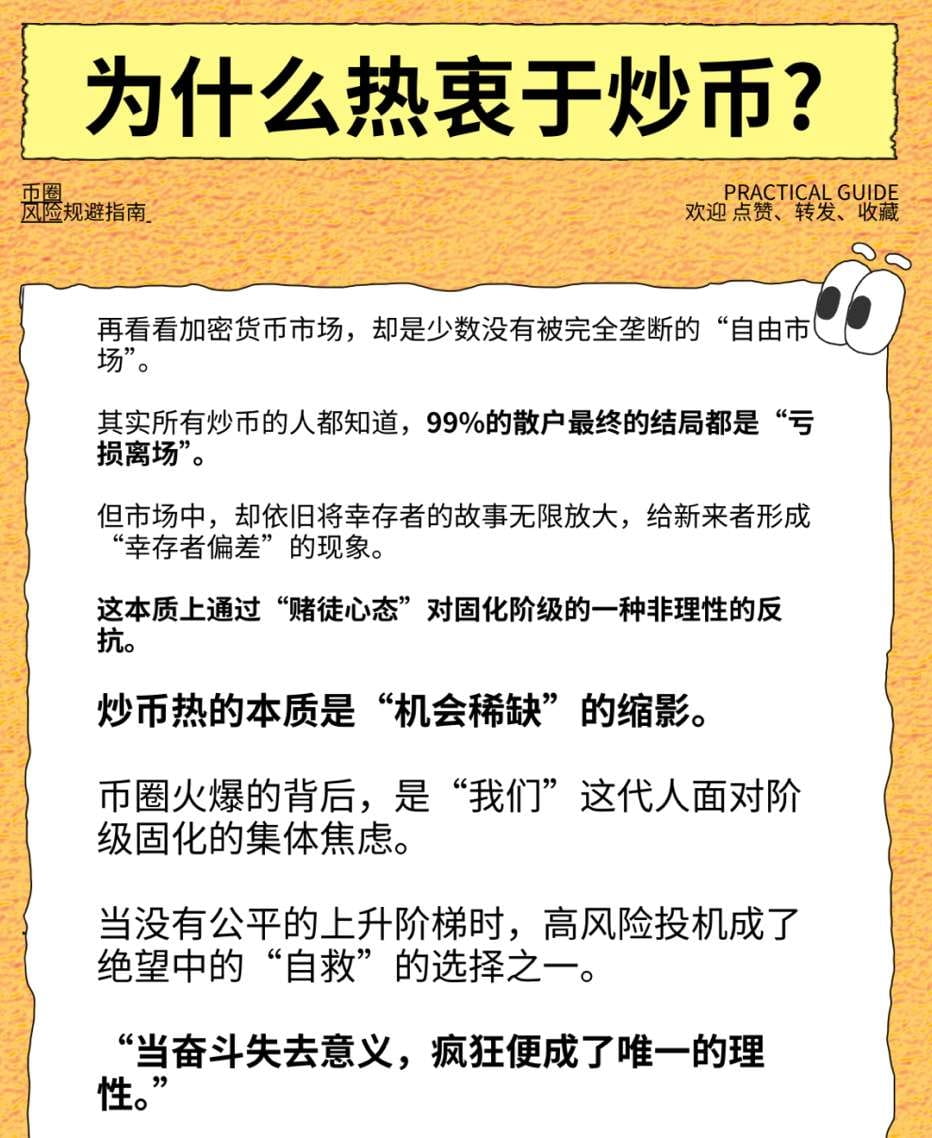
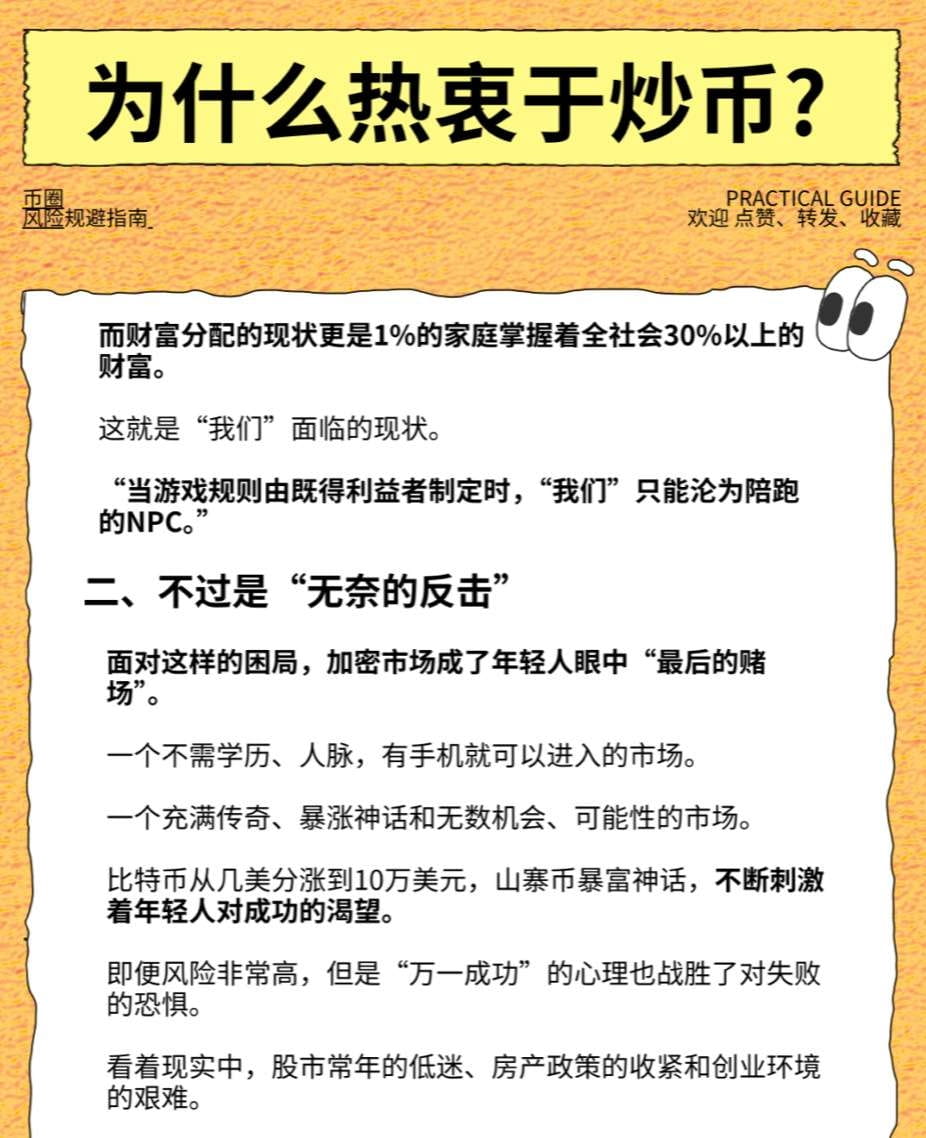
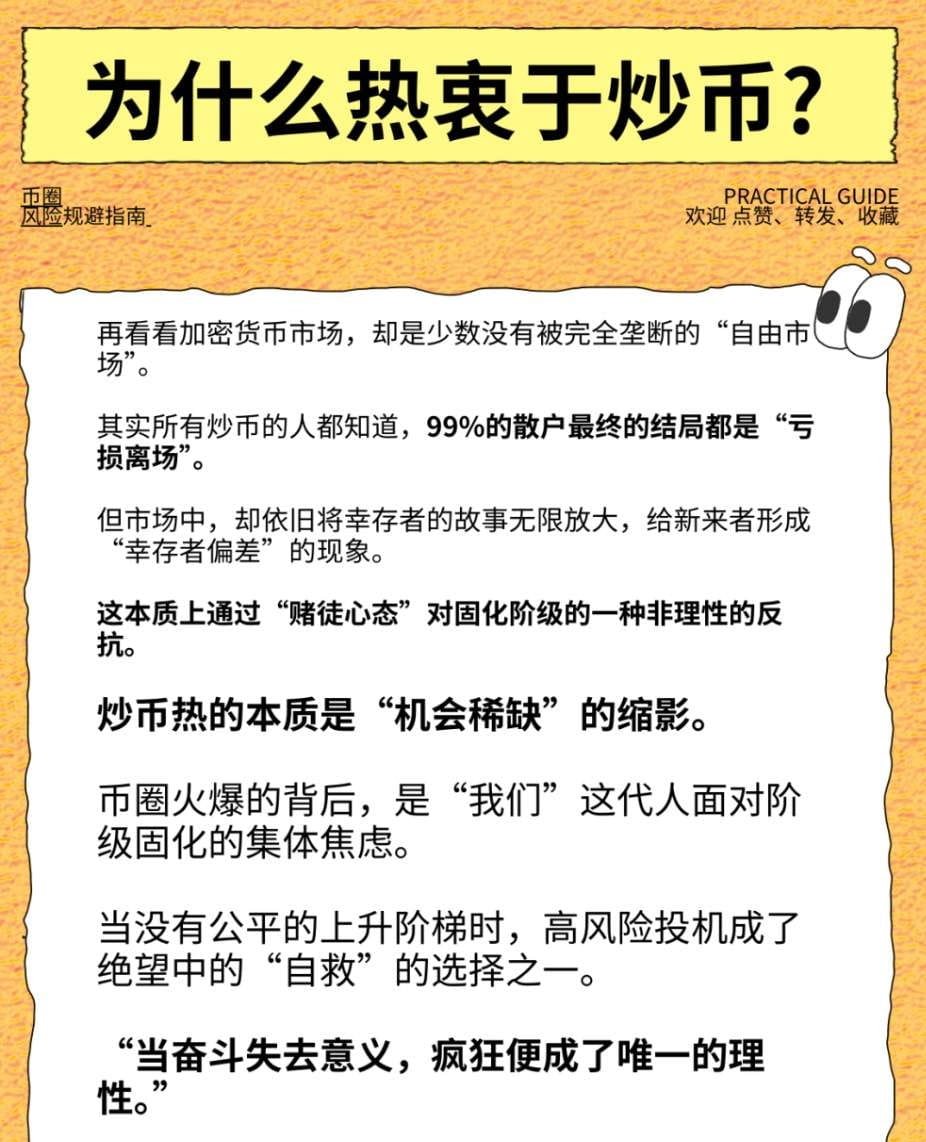
Article 4
When waiting for a bull market, survive the reshuffle first...
"Buy when no one cares, sell when the crowd is in an uproar." Anyone who has survived several cycles in the market should have heard this phrase. But most people only know its form, not its true meaning. The real 'no one cares' often comes with the despair of retail investors. Repeatedly bottom fishing and cutting losses, numbness after deep entrapment, the accumulation of sluggish market news... Many times when it seems like the market is at the bottom, it is actually the time of human nature's battle.
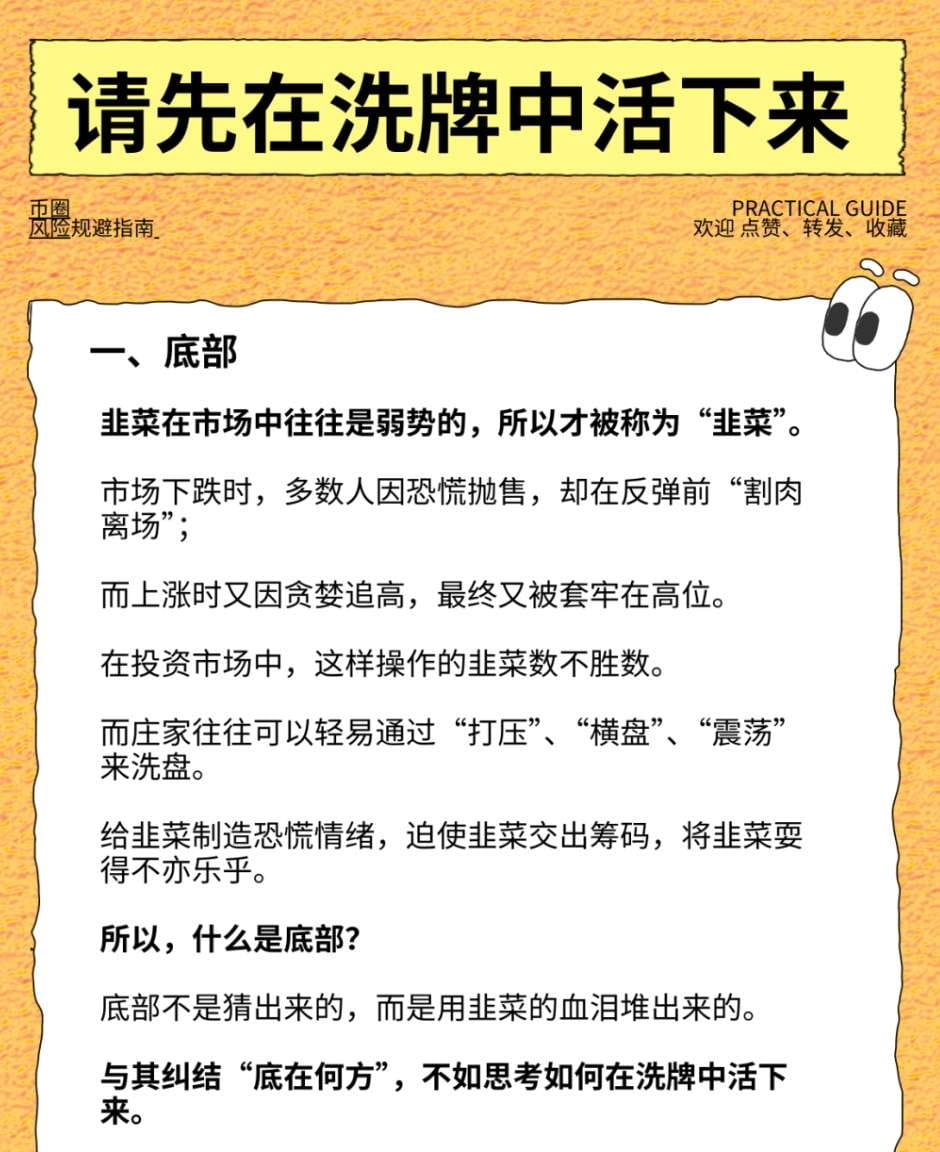
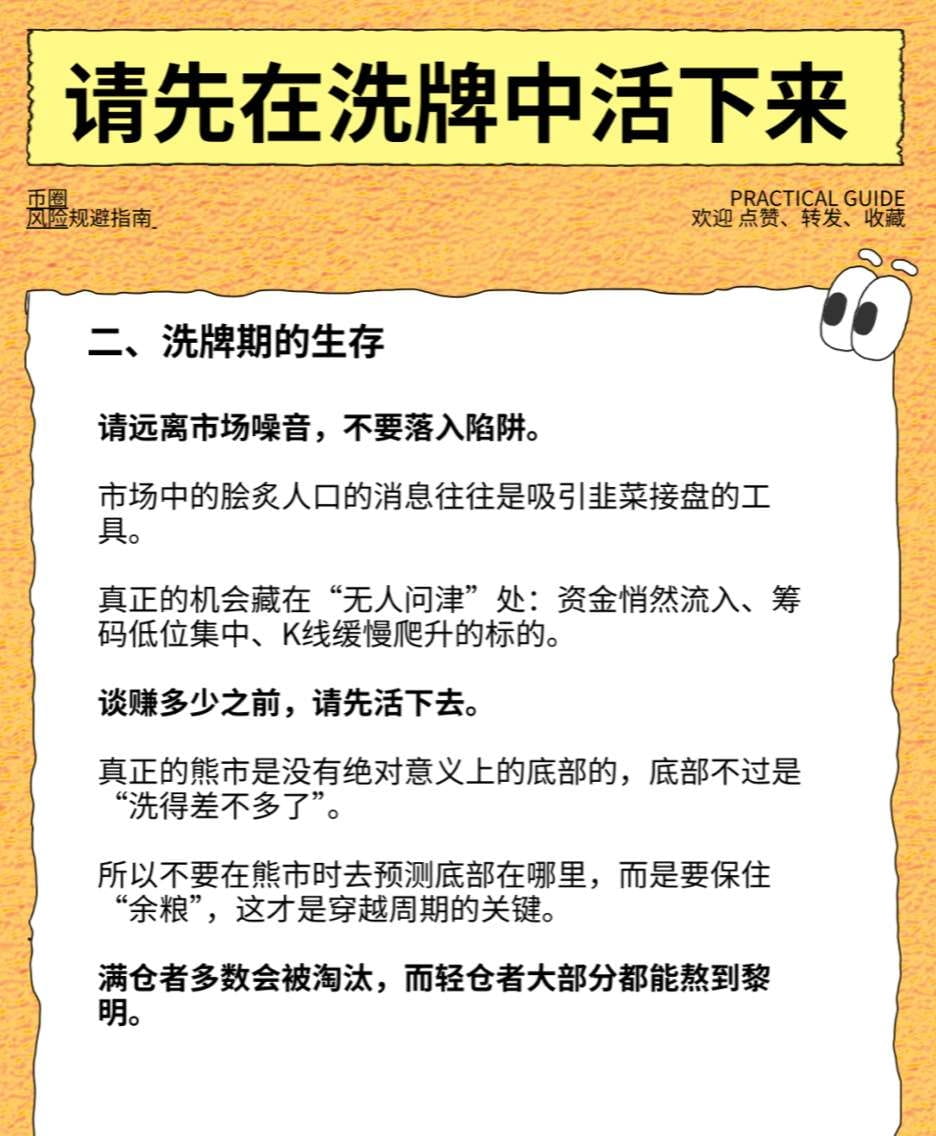
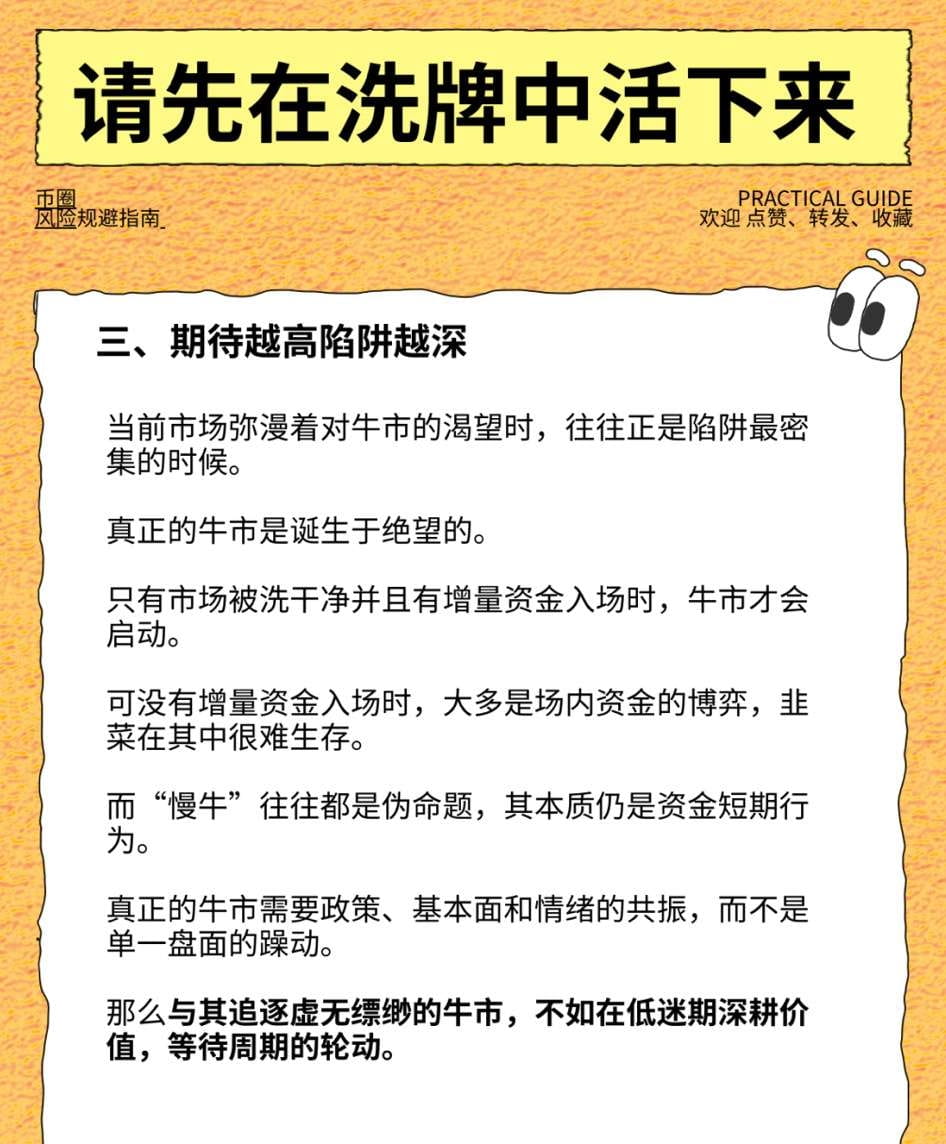
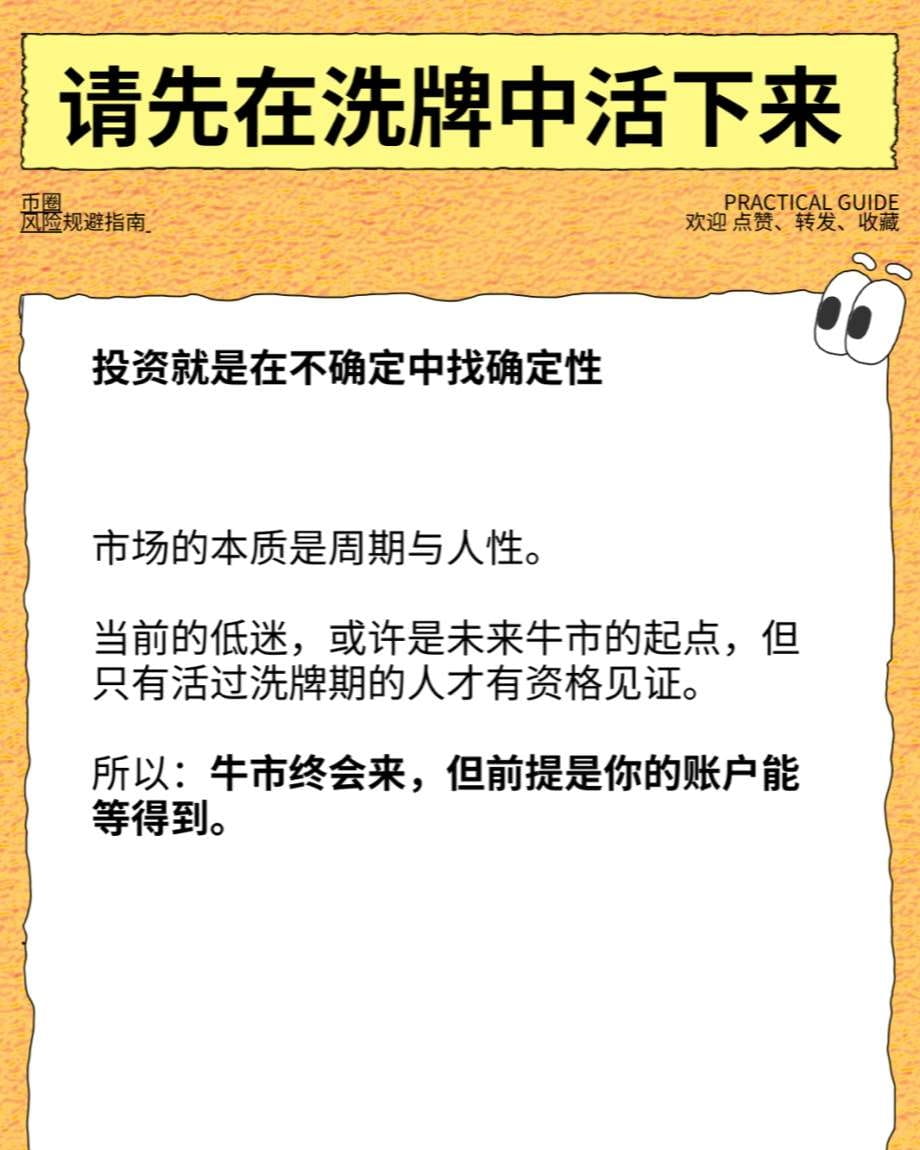
The truth of surviving in the crypto world: Only those who endure can make money.
The market has never lacked opportunities; what it lacks are people who can 'stay steady, endure, and survive.' Don't envy the 'luck' of the experts; they are just applying these 'simple methods' to the extreme — using patience to combat volatility, using discipline to control risks, and using strategy to seize opportunities.
Remember: In the crypto world, it's not 'smart money' that earns, but 'hard work.' Understanding these iron rules, controlling your actions, enduring, and executing steadily will widen your path in trading, transforming from being harvested as 'chives' to becoming the 'hunters.'
Final reminder: There are risks in the crypto world, and operations should be cautious, but as long as you master these 'simple methods', you can establish a foothold in the market.